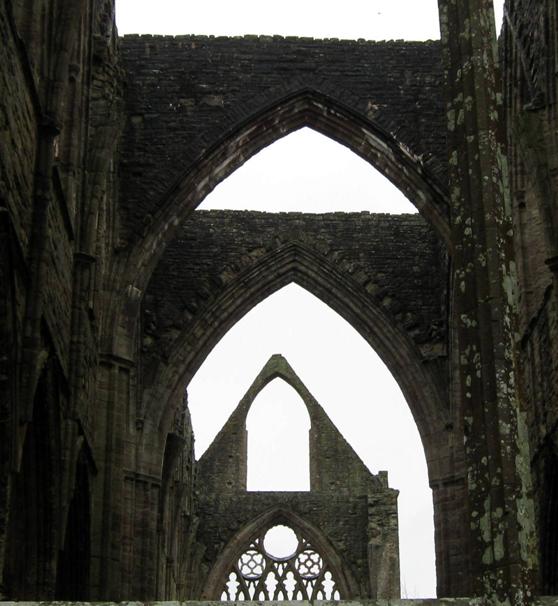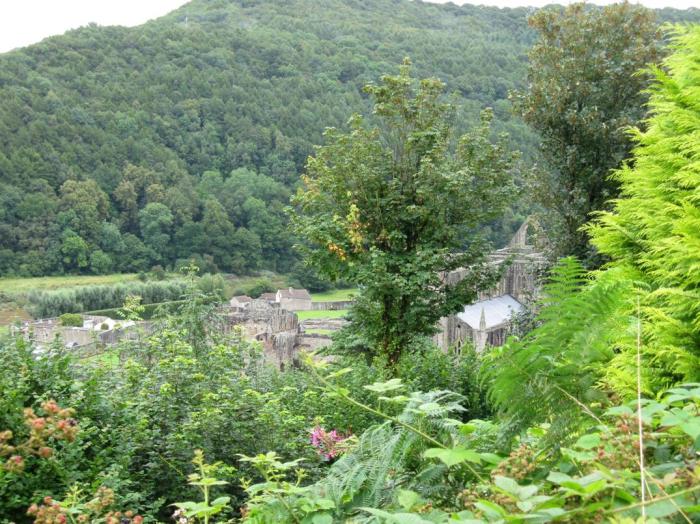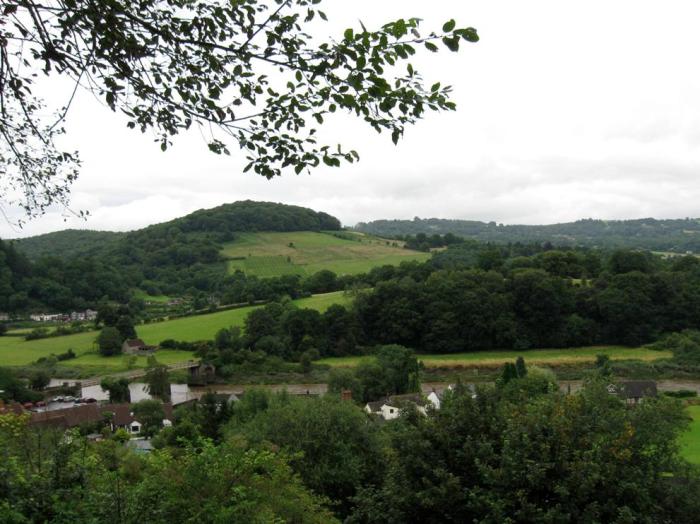One morning in early July of 2009, I was contemplating ways and means to avoid thinking and writing out my dissertation, a dissertation which would culminate a year’s worth of stay and study in London. It was a year in which I studied a bit and travelled a bit (though not necessarily in that order). So when I received a mail about a day trip to Wales for a very affordable sum from the travel club I was a member of, I immediately signed up for it. So desperate I was to escape my dissertation that I didn’t even look at the details of where we would be travelling to in Wales.
It was only when I got into the tour bus that I got to know that we were headed for Tintern Abbey and Chepstow Castle via Gloucester. Now while neither Chepstow not Gloucester sounded familiar, Tintern seemed very very familiar. Literarily familiar. English school book familiar. But I just couldn’t place it nor get it out of my head. Even the heavy rain, which followed us all the way to Tintern and beyond and back to London, couldn’t distract me from trying place Tintern Abbey. By the time we reached Gloucester, I could take the uncertainty no more and sent a text message to my brother back home in India, asking him why Tintern sounded so familiar.
His reply took a long time coming. The route to Tintern from Gloucester took us through the ancient and beautiful Forest of the Dean, where upon Tintern vanished from my mind to be replaced by Harry Potter ! Tintern returned to my thoughts only after we left the Forest and passed through some of the most beautiful villages imaginable.
Just as I noticed the signboard for Tintern, my cell phone beeped. It was a one word text message from my brother, which said “Wordsworth”. A single word was all that it took me to place Tintern in context.

Tintern Abbey was the source of inspiration and setting for many artists and poets. Wordsworth’s ‘Lines Composed a Few Miles Above Tintern Abbey‘, Tennyson’s ‘Tears, Idle Tears‘, and Turner’s many paintings of the Abbey, are just but a few examples.
And why not? Tintern Abbey is a story of glory, riches, and ultimately ruin. It is the story of a lost era of monasticism and piety in the verdant green Wye valley of Wales. It is the story of how a single act of the King of England, Henry VIII, sealed a ruinous end for the first abbey of Wales.

Tintern Abbey was founded in 1311 as a Cistercian Monastery by Walter Fitz Richard of Clare, the Anglo-Norman Lord of the neighbouring town of Chepstow. Over the years, the Abbey countinued to grow both spiritually and materially. And then with the Reformation in the 1530s, the Abbey lost its independence, its wealth, its estates—its very existence. The Abbey was disbanded and the monks were forced to leave it.

Henry VIII created the Church of England and himself as its supreme leader. One of his first acts was to abolish all monasteries and annex or sell off their properties. Henry VIII granted the bulk of the Abbey’s estates to Henry Somerset, the Earl of Worcester. Somerset chose to lease out the tenements and parcels of land in and around the former monastic buildings, and even the rooms around the cloisters of the Abbey itself. With the Industrial Revolution came the machines and they came into the Abbey as well in the form of furnaces to produce iron wire. That accelerated the ruin and by the time the furnaces stopped working, the buildings were reduced to a shell. Today, only the walls of the Abbey Church are standing; all the other buildings are gone.


The Abbey is constructed alomost entirely of red sandstone and some limestone—two building stones which, I feel, always convey stories and tales of centuries gone by very evocatively. In spite of the rain, the walls were quite warm to touch, almost like they were alive. In fact, I felt like I had entered another time, another dimension.

 Walking around the ruins of the Abbey and its surrounding grounds, it was not very difficult to imagine why it became a magnet for the romanticists among artists and poets in the late 18th century. It was only through their work, that the world became aware of the existence of the ruins of Tintern Abbey. Today, the ruins are being looked after by the Welsh Government’s historic environment division for conservation and maintenance.
Walking around the ruins of the Abbey and its surrounding grounds, it was not very difficult to imagine why it became a magnet for the romanticists among artists and poets in the late 18th century. It was only through their work, that the world became aware of the existence of the ruins of Tintern Abbey. Today, the ruins are being looked after by the Welsh Government’s historic environment division for conservation and maintenance.
The brochure on Tintern Abbey that I purchased at the ticket office mentioned the presence of another set of ruins a 15-20 minute walk away—the ruins of the Chapel of St. Mary-on-the-Hill, which was built for the stonemasons of Tintern Abbey. It also promised a view of the Wye Valley, the source of inspiration for so many creative souls. I needed no further inducement and I trotted off. A steep 25-minute climb up a slippery pathway and I was at the ruins of the Chapel of St.Mary-on-the-Hill.

Though the Chapel is no longer a place of worship, the surrounding graveyard is still used for burials by the local people.

I am all alone among the chapel ruins and the graveyard. A part of me tells me I should be spooked, but strangely I am not. I am comforted by the fact that so many have been laid to rest and peace. Another part of me says that I would not feel so brave at night. Probably. But right then I am feeling comfortable and at peace. Suddenly, I spy a gap among the overgrowth and walk up to it to see the ruins of the Tintern Abbey and the Wye Valley spread out below me. I wonder if this is the same view that inspired Wordsworth and many others.


I feel truly blessed to be standing here and offer a prayer for all those who toiled to create such a magnificient structure like the Tintern Abbey, for all those who watched the mindless ruin of the Abbey, and for all those laid to rest in this graveyard and whose peace I may have disturbed.
Even 2 years later, I cannot forget that day among the ruins in the midst of rains. A day spent in another era, another time. A day spent alone in contemplation and listening to the stories that the ruins had to narrate. A beautiful day.

Beautiful post and great images. I too love to travel, go around and try to understand about history, geography, culture of places. Reading you was like going there! 🙂
LikeLike
Welome to my blog, Sunil, and thank you so much for your comments. You have a great blog too and thanks to you I have picked up a few words in Italian. 🙂
LikeLike
Thank you for the great pictures and commentary ! Love those arches !
Ed
LikeLike
Thank you for stopping by and commenting, Ed. I love those arches too ! 🙂
LikeLike
Bautiful narration & pics liked it a lot.
LikeLike
Thank you, Arnavaz. I hope you get to see Tintern Abbey one day.
LikeLike
This is a beautiful post…. the pictures are a feast for the eyes Sudha. Very well compiled.
LikeLike
Thanks, Deboshree. Many visitors to the UK or even Wales do not visit Tintern Abbey, which is a shame I feel as it is one of the most beautiful places that I have visited. Granted that ruins are not everyone’s cup of tea, I still feel that Tintern should be on everyone’s list of places to visit. And Wales is much more gentler than the rest of the UK.
LikeLike
There is something inherently fascinating about monuments in ruins. On the one hand you feel sad for the sorry state of affairs, but then again you are thankful that the remains exist, else you’d never get that experience. Also it leaves you impressed with the quality of work that has gone behind such monuments, which are still standing strong after so many centuries
LikeLike
My sentiments exactly. Though you have put it far better than I could have done. 🙂
LikeLike
How do you get there via public transportation from London?
LikeLike
The pictures are refreshing! and the description is PERFECT!
LikeLike
Welcome to my blog, binny, and thank you for stopping by and commenting.
LikeLike
This has been a treat for me. I was fortunate to see Tintern Abbey in 1972 when hitch hiking in the area. I stayed in a private home not far from the Abbey, and visited it several times, always in awe of its age and beauty. I still have a postcard of it. Thank you for your story and pictures.
LikeLike
Check out my post on the ruins of Awantipura here: http://thegalnxtdoor.wordpress.com/2012/08/10/kashmir-travelogue-7-sights-in-and-around-srinagar/
Off to read your post now! 😀
LikeLike
LOVED the post! I have always been fascinated by Wales. Now, there’s good reason to visit! 🙂
Tintern Abbey sounded very familiar to me, too, since I read the name of this post. Now, I know why.
LikeLike
Thanks, TGND. Though every trip of mine is special, this visit to Tintern Abbey is beyond special and something that just words will cannot convey. 🙂
LikeLike
A lovely capture of the aura not just through your camera but also with your words. You truly love this, clearly seen in your writings. 🙂
LikeLike
There is something about ruins that connects at an emotional level and something like the Tintern Abbey is almost like a pilgrimage 🙂
LikeLike